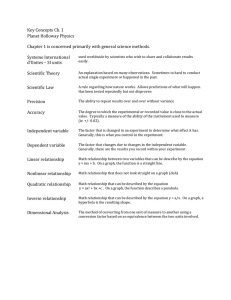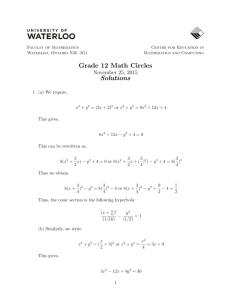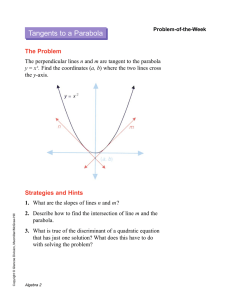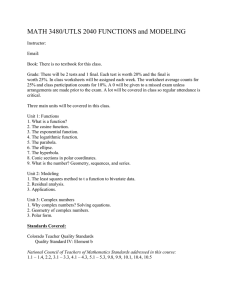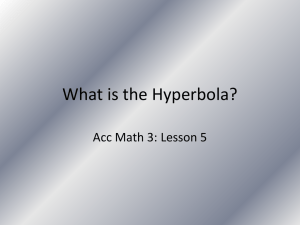comparing parabolas and branches of hyperbolas
advertisement
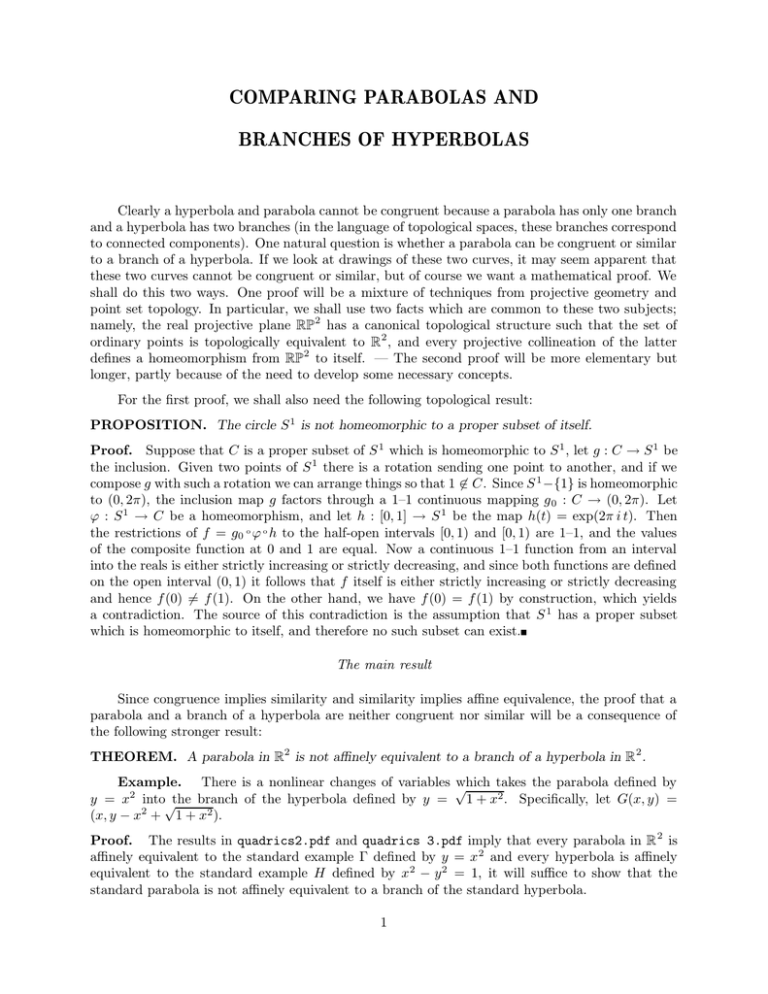
COMPARING PARABOLAS AND
BRANCHES OF HYPERBOLAS
Clearly a hyperbola and parabola cannot be congruent because a parabola has only one branch
and a hyperbola has two branches (in the language of topological spaces, these branches correspond
to connected components). One natural question is whether a parabola can be congruent or similar
to a branch of a hyperbola. If we look at drawings of these two curves, it may seem apparent that
these two curves cannot be congruent or similar, but of course we want a mathematical proof. We
shall do this two ways. One proof will be a mixture of techniques from projective geometry and
point set topology. In particular, we shall use two facts which are common to these two subjects;
namely, the real projective plane RP 2 has a canonical topological structure such that the set of
ordinary points is topologically equivalent to R 2 , and every projective collineation of the latter
defines a homeomorphism from RP2 to itself. — The second proof will be more elementary but
longer, partly because of the need to develop some necessary concepts.
For the first proof, we shall also need the following topological result:
PROPOSITION. The circle S 1 is not homeomorphic to a proper subset of itself.
Proof. Suppose that C is a proper subset of S 1 which is homeomorphic to S 1 , let g : C → S 1 be
the inclusion. Given two points of S 1 there is a rotation sending one point to another, and if we
compose g with such a rotation we can arrange things so that 1 6∈ C. Since S 1 −{1} is homeomorphic
to (0, 2π), the inclusion map g factors through a 1–1 continuous mapping g 0 : C → (0, 2π). Let
ϕ : S 1 → C be a homeomorphism, and let h : [0, 1] → S 1 be the map h(t) = exp(2π i t). Then
the restrictions of f = g0 o ϕ o h to the half-open intervals [0, 1) and [0, 1) are 1–1, and the values
of the composite function at 0 and 1 are equal. Now a continuous 1–1 function from an interval
into the reals is either strictly increasing or strictly decreasing, and since both functions are defined
on the open interval (0, 1) it follows that f itself is either strictly increasing or strictly decreasing
and hence f (0) 6= f (1). On the other hand, we have f (0) = f (1) by construction, which yields
a contradiction. The source of this contradiction is the assumption that S 1 has a proper subset
which is homeomorphic to itself, and therefore no such subset can exist.
The main result
Since congruence implies similarity and similarity implies affine equivalence, the proof that a
parabola and a branch of a hyperbola are neither congruent nor similar will be a consequence of
the following stronger result:
THEOREM. A parabola in R2 is not affinely equivalent to a branch of a hyperbola in R 2 .
Example. There is a nonlinear changes of variables √
which takes the parabola defined by
2
y = x into√the branch of the hyperbola defined by y = 1 + x2 . Specifically, let G(x, y) =
(x, y − x2 + 1 + x2 ).
Proof. The results in quadrics2.pdf and quadrics 3.pdf imply that every parabola in R 2 is
affinely equivalent to the standard example Γ defined by y = x 2 and every hyperbola is affinely
equivalent to the standard example H defined by x 2 − y 2 = 1, it will suffice to show that the
standard parabola is not affinely equivalent to a branch of the standard hyperbola.
1
Suppose that there is an affine transformation T (x) = P x = q which maps P onto a branch
H0 of H. Let T ∗ be the projective collineation of RP 2 extending T . The closures Γ∗ and H ∗ of Γ
and H are the nonsingular projective conics defined by the homogeneous equations u 21 − u2 u3 = 0
and u21 − u22 − u23 = 0, and by continuity the unique point at infinity in Γ ∗ , which has homogeneous
coordinates (0, 1, 0), must be a point at infinity in H ∗ . It follows that T ∗ maps Γ∗ onto a proper
subset of H ∗ .
By the projective classification of nonsingular conics in R 2 in Chapter 7 of
http://math.ucr.edu/∼res/progeom/pg-all.pdf
and the continuity of projective collineations, all such subsets are homeomorphic to the standard
example, which is the unit circle in R 2 . Therfore the preceding paragraph implies that S 1 ∼
=
H ∗ contains a proper subset (corresponding to Γ ∗ ) which is homeomorphic to S 1 . By the first
proposition this cannot happen, and therefore our original hypothesis — namely, Γ is affinely
equivalent to a branch of H — must be false, proving the theorem.
An alternate approach
Not surprisingly, there are several ways to prove that a parabola and a branch of a hyperbola
are not similar. We shall describe a proof which does not (explicitly) use projective geometry and is
based upon vector parametrizations of curves as described in first and second year calculus courses
(and presented in more depth in differential geometry courses). The main idea behind the approach
taken here is to justify a basic intuitive way of distinguishing between a hyperbola and a parabola;
namely, hyperbolas have asymptotic lines in the Euclidean plane but parabolas do not. Much of
the work involves defining suitable notions of asymptotic tangent vectors for parametrized curves
and deriving some of their fundamental properties.
We shall begin with a standard observation about tangent lines to nice curves and their independence of the choice of parametrization. This will be a consequence of the following result:
PROPOSITION 0. Let γ be a regular smooth curve in R n (so that it has a continuous derivative
everywhere). Assume that γ is 1 − 1 and γ((t 0 ) = p. If h is a regular reparametrization of γ and
h(u0 ) = t0 , then the unit tangent vectors vγ (t0 ) and vγ h (u0 ) are equal up to sign.
A reparametrization t = h(u) is regular if it has a continuous nonzero derivative everywhere
(by continuity it must be either positive everywhere or negative everywhere). Note that if we take
the “time reversal” reparametrization u = −t, then v γ (t0 ) = −vγ h (u0 ).
Proof. By the Chain Rule we have
γ 0 (t) =
1
· (γ o h)0 (u)
h0 (u)
and since h0 is always nonzero the unit vectors in the directions of the left and right hand sides,
which are vγ (t0 ) and vγ h (u0 ) respectively, are either equal (if h 0 > 0) or point in diametrically
opposite directions (if h0 < 0).
From this point on, we shall be considering regular curves which are parametrized over the
entire real line such that
lim
t→+∞
|γ(t)| =
lim
t→−∞
2
|γ(t)| = ∞ .
Note that if h is a regular reparametrization and ε h = ± 1 depending upon the sign of h0 , then
lim
t→+∞
h(u) = εh ∞ ,
lim
t→−∞
h(u) = −εh ∞
and hence the limit conditions remain true if γ is replaced by a reparametrization of itself.
Geometric intuition suggests that if γ satisfies the limit conditions in the preceding paragraph,
then the latter also hold for a curve which is congruent or similar to γ. Our next result confirms
this.
THEOREM 1. Let γ be a regular smooth curve parametrized over R such that |γ(t)| → ∞ as
t → +∞ and as t → −∞, and let T (x) = c P x + q be a similarity transformation of R n , where P
is an orthogonal matrix, q ∈ Rn and c > 0. Then the following hold:
(i) We have |T o γ(t)| → ∞ as t → +∞ and as t → −∞.
(ii) If in addition the unit tangent vector v γ (t) has limits vγ (+∞) and vγ (−∞) as t → +∞
and as t → −∞ (respectively), then the unit tangent vector v T γ (t) also has such limits and
lim
t→+∞
vT γ (t) = P vγ (+∞) ,
lim
t→−∞
vT γ (t) = P vγ (−∞) .
Note that since |vγ (t)| = 1 for all t and the length of a vector is a continuous function, then if the
limits in (ii) exist we have |vγ (+∞)| = |vγ (−∞)| = 1.
Before proving this result, we shall verify that the hypotheses in both parts are satisfied if γ
is a standard example of a parametrized parabola or a parametrized branch of a hyperbola, and in
the latter case the vectors vγ (+∞) and vγ (−∞) are direction vectors for the asymptotes.
Example 1. Hyperbolas. Suppose that γ is the branch of the hyperbola defined by
y2
x2
−
a2
b2
= 1
(x > 0)
with parametrization γ(t) = (a cosh t, b sinh t) such that A, b > 0. For this example we have γ 0 (t) =
(a sinh t, b cosh t), and standard calculations with hyperbolic functions imply that |γ(t)| → ∞ as
t → +∞ and t → −∞ and also
a
b
−a
b
√
√
vγ (+∞) =
, vγ (−∞) =
.
,√
,√
a2 + b2
a2 + b2
a2 + b2
a2 + b2
Since the asymptotes to the hyperbola are defined by
y2
x2
−
a2
b2
= 0
the unit vectors vγ (+∞) and vγ (−∞) are direction vectors for the asymptotes to the hyperbola.
Note that these vectors are linearly independent because a, b > 0.
Example 2. Parabolas. Suppose that γ is the parabola defined by y = c x 2 , where c > 0.
If we take the standard graph parametrization γ(t) = (t, c t 2 ), and standard techniques from first
year calculus imply that |γ(t)| → ∞ as t → +∞ and t → −∞ and also
vγ (+∞) = (0, 1) ,
vγ (−∞) = (0, −1) .
3
In this case the limit vectors are linearly dependent.
Proof of Theorem 1. (i) By the Chain Rule and the formula for T we have
d
= c P γ 0 (t) .
dt
Since v(t) is a unit vector pointing in the same direction as γ 0 (t) and P preserves lengths it follows
that vT γ (t) = P vγ (t) for all t. The continuity of the map sending y to P y then implies that
vT γ (± ∞) =
lim
t→± ∞
vT γ (t) =
lim
t→± ∞
P vγ (t) = P vγ (± ∞) .
ASYMPTOTIC ANGLES. If both vγ (+∞) and vγ (−∞) exist, then we can define an asymptotic
angle for γ by the formula
cos α(γ) = hvγ (+∞), vγ (−∞)i
(recall that the vectors in this expression are unit vectors, so the inner product is the cosine of
the angle between them). By Theorem 1, standard limit formulas, and the bilinearity of the
inner product, if h is a regular reparametrization then we have cos α(γ) = cos α(γ o h), so that
α(γ) = α(γ o h).
The next result implies that if a curve has an asymptotic angle, then this property and the
measure of the angle do not change if we apply a similarity transformation to γ.
THEOREM 2.
let γ be as above, assume that v γ (+∞) and vγ (−∞) exist, and let T be a
similarity transformation with the same notation as in Theorem 1. Then α(T o γ) = α(γ).
Proof. Since |vT γ (± ∞)| = |vγ (± ∞)| = 1 we have
α(T o γ) = hP vγ (+∞), P vγ (−∞)i = hvγ (+∞), vγ (−∞)i = α(γ)
where the next to last equation holds because the orthogonal matrix P preserves inner products.
We can now prove the main result.
THEOREM 3.
hyperbola.
A parabola is not similar (and hence is also not congruent) to a branch of a
Proof. By the results on congruence classification in quadrics3.pdf every parabola is congruent
to one which is defined by an equation of the form y = c x 2 for some c > 0, and every hyperbola is
equivalent to one defined by an equation of the form
y2
x2
−
= 1
(a, b > 0) .
a2
b2
Furthermore, the hyperbola is congruent to itself by the isometry sending (x, y) to (−x, y) and
that each branch is sent to the other. Therefore it suffices to show that the given parabola is
not congruent to the branch of the hyperbola defined by the displayed equation and x > 0; as
before, this branch can be parametrized as γ(t) = (a cosh t, b sinh t), so it is enough to show that a
hyperbola of this type is not congruent to a parabola with parametric equations δ(t) = (t, c t 2 ). In
the examples we showed that
b2 − a 2
,
α(δ) = −1
a2 + b 2
so by Theorem 2 the proof of Theorem 3 reduces to observing that
α(γ) =
2 b2
b2 − a 2
=
−1
+
a2 + b 2
a2 + b 2
where the inequality on the right holds because b > 0.
4
> −1
